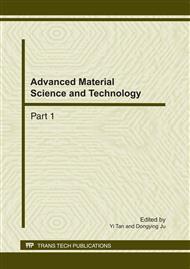p.1225
p.1229
p.1233
p.1237
p.1241
p.1245
p.1249
p.1253
p.1259
Analysis on the Mechanical and Electrical Properties of PI/MWNTs Nano-Hybrid Films
Abstract:
In this paper, MWNTs (multi-walled carbon nanotubes) were modified by the mixture acid of H2SO4 and HNO3, the PI (polyimide)/MWNTs nano-hybrid films were prepared by means of ultrasonic vibration and in-situ polymerization. The surface morphology was characterized by SEM, the chemical structure was characterized by FT-IR. The tensile strength and Young’s modulus increased at first and then decreased with the increase of MWNTs content. The dielectric constant was tested at a frequency of 1 kHz. The dielectric constant had no obvious variation when MWNTs content was less than 2.9 wt%, as the MWNTs content exceeded 5.36 wt%, the dielectric constant increased rapidly. In general, the dielectric loss of PI/MWNTs nano-hybrid films was higher than the dielectric loss of pure polyimide films. The dielectric loss increased slowly in low frequency region but rapidly in high frequency region. All the test results were attributed to the dispersion degree of MWNTs doping and the combination degree between PI matrix and modified MWNTs in PI/MWNTs nano-hybrid films.
Info:
Periodical:
Pages:
1241-1244
Citation:
Online since:
February 2011
Authors:
Price:
Сopyright:
© 2011 Trans Tech Publications Ltd. All Rights Reserved
Share:
Citation:


